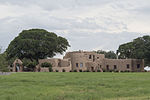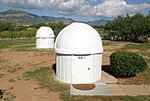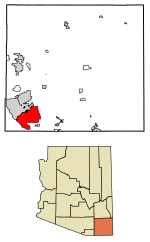Coronado National Memorial
1952 establishments in ArizonaGeography of Cochise County, ArizonaIUCN Category IIIMexico–United States borderMonuments and memorials in Arizona ... and 9 more
Monuments and memorials on the National Register of Historic Places in ArizonaNational Memorials of the United StatesNational Park Service areas in ArizonaNational Register of Historic Places in Cochise County, ArizonaParks in ArizonaPeace parksProtected areas established in 1952Protected areas of Cochise County, ArizonaSpanish colonization of the Americas

The Coronado National Memorial commemorates the first organized expedition into the Southwest by conquistador Francisco Vásquez de Coronado in 1540. The memorial is located in a natural setting on the Mexico–United States border on the southeast flank of the Huachuca Mountains south of Sierra Vista, Arizona and is bordered to the north and west by Coronado National Forest. Within the memorial is an overlook at Montezuma Pass where the Coronado expedition entered modern Arizona. The memorial confirms the ties that bind the United States and Mexico.
Excerpt from the Wikipedia article Coronado National Memorial (License: CC BY-SA 3.0, Authors, Images).Coronado National Memorial
Montezuma Canyon Road,
Geographical coordinates (GPS) Address Nearby Places Show on map
Geographical coordinates (GPS)
| Latitude | Longitude |
|---|---|
| N 31.348333333333 ° | E -110.27166666667 ° |
Address
Montezuma Canyon Road
Montezuma Canyon Road
Arizona, United States
Open on Google Maps








